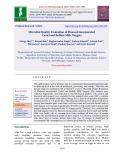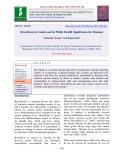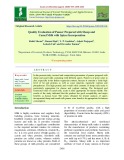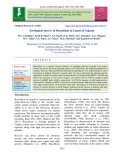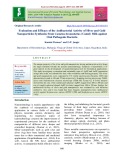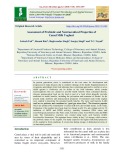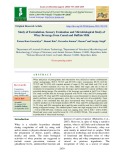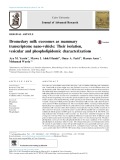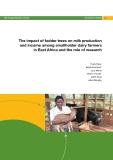
Camel milk
-
Whey acidic protein (WAP) is a major protein identified in the milk of several mammalian species with cysteine-rich domains known as four-disulfide cores (4-DSC). The organization of the eutherian WAP genes is highly conserved through evolution.
 10p
10p  vihagrid
vihagrid
 30-01-2023
30-01-2023
 3
3
 3
3
 Download
Download
-
The milk products and by products may be contaminated intentionally/unintentionally at different level at the time of production, processing, and storage. Therefore, the present study was conducted with an objective to assess Microbial Quality Evaluation of Flaxseed incorporated Camel and Buffalo Milk Nuggets. The samples were collected hygienically and subjected to microbiological analysis.
 9p
9p  cothumenhmong11
cothumenhmong11
 11-05-2021
11-05-2021
 6
6
 2
2
 Download
Download
-
Brucellosis is a zoonotic disease that affects all domestic animals including camels. It is infectious to human beings also. Camels are infected by B. melitensis and Brucella abortus. Infection is transmitted to humans from infected animals mainly by direct or indirect contact with animals and consumption of unpasteurized milk and contaminated meat and milk products. Here we review Brucellosis in camel and various aspects of its zoonotic transmission to humans.
 18p
18p  trinhthamhodang11
trinhthamhodang11
 27-04-2021
27-04-2021
 11
11
 2
2
 Download
Download
-
In the present study, textural and composition parameters of paneer prepared with sheep and camel milk containing with different spices. Paneer is of great value in diet, especially in the Indian vegetarian context, because it contains a fairly high level of fat and proteins as well as some minerals, especially calcium and phosphorous.
 6p
6p  trinhthamhodang9
trinhthamhodang9
 16-12-2020
16-12-2020
 15
15
 2
2
 Download
Download
-
Camel milk is generally produced in very remote areas and far from cities. Therefore, a viable alternate for earning from camel milk appears to convert camel milk into a product with better shelf life. For this purpose manufacture of khoa and its utilization in preparation of sweets like gulabjamun is the most appropriate and viable option. Some defects like poor porosity, insufficient penetration of the sugar syrup, hard central core with doughy feel and typical off taste are the bottlenecks.
 8p
8p  trinhthamhodang1215
trinhthamhodang1215
 23-09-2020
23-09-2020
 11
11
 2
2
 Download
Download
-
The present study was aimed to estimate the sensory properties and microbiological study of camel and buffalo milk based khoa burfi. Four treatment samples were developed by using different combination with watermelon seeds in selected camel and buffalo milk khoa viz. Control (without watermelon seeds incorporation) and treatments T1,T2 and T3 with 10%, 20% and 30% watermelon seeds incorporation respectively.
 12p
12p  caygaocaolon6
caygaocaolon6
 30-07-2020
30-07-2020
 2
2
 1
1
 Download
Download
-
Brucellosis is a zoonotic bacterial disease of ruminants and also reported from camel. Camels are one of the most important sources of livelihood for the nomadic population of Gujarat. There are limited published information regarding the sero-epidemiology of camel brucellosis in Gujarat. Therefore, present study was aim to determine the brucella specific antibodies in camel from three camel rearing districts of Gujarat using RBPT, i-ELISA and MRT. On screening of 352 serum samples, 41(11.64%) and 16 (4.54%) samples found positive by RBPT and i-ELISA, respectively. 8 (15.
 7p
7p  angicungduoc6
angicungduoc6
 20-07-2020
20-07-2020
 14
14
 2
2
 Download
Download
-
The unique property of the silver and gold nanoparticles having antibacterial activity drags the major attention towards the present nanotechnology. Synthesis of nanobodies is of great interest in the development of nanotechnological tool for biomedical applications. This study investigates a competent and sustainable route of AgNP and AuNP preparation using Camel milk, well adorned for their wide availability and healing property. The silver and gold nanoparticles were examined by UV-visible spectroscopy (Systonic 2203) that demonstrated a peak at 446 and 551nm respectively.
 6p
6p  kethamoi6
kethamoi6
 29-06-2020
29-06-2020
 11
11
 1
1
 Download
Download
-
In present generation, stress is considered as the root cause for development and progression of many diseases due to oxidative damage of the health. Supplementation of exogenous antioxidants from food substance has a promising approach to combat or act as shield against it. Probiotics can be define as the food substance which contain microorganisms that are claimed to provide health benefits when consumed directly, whereas neutraceutical food are the food or part of a food which allegedly provides medicinal or health benefits, including the prevention and treatment of disease.
 7p
7p  angicungduoc5
angicungduoc5
 14-06-2020
14-06-2020
 4
4
 0
0
 Download
Download
-
Whey and juices of pomegranate and watermelon were utilized at various combinations (whey: pomegranate, 89.5:5, 79.5:15 and 69.5:25) (whey: watermelon, 89.5:5, 84.5:10, 79.5:15 and 74.5:20) with constant amount of sugar (4.5%) and black salt (1%) in all samples. Control treatment (T0) was the whey added with sugar and salt as that of treatments for preparation of nutritious beverages and evaluated for sensory attributes and microbial during storage.
 6p
6p  kethamoi5
kethamoi5
 03-06-2020
03-06-2020
 11
11
 0
0
 Download
Download
-
The camel rearing communities in Rajasthan are witnessing the degradation of livelihood which they were doing for decades. Camels that were previously used for the transportation of goods and men are now not a viable option due to the affordability of fossil fuel transportation.
 11p
11p  nguaconbaynhay4
nguaconbaynhay4
 22-03-2020
22-03-2020
 18
18
 0
0
 Download
Download
-
India ranks tenth in the world with 0.38 million camel population. In November 2016, the Food Safety and Standards Authority of India (FSSAI) had approved camel milk for sale purpose. Camel milk is rich in minerals like Iron (0.32-0.36 mg/dl), Zinc (1.2-6.3 mg/dl), Copper (0.09-0.5 mg/dl) and Vitamins B1 (0.03 mg%), Vitamin B6 (0.05 mg%), Vitamin B12 (0.0002 mg%) and Vitamin C (40- 50 mg/kg).
 7p
7p  chauchaungayxua4
chauchaungayxua4
 18-03-2020
18-03-2020
 7
7
 0
0
 Download
Download
-
Exosomes are extracellular nanovesicles that play a role in cellular trafficking and communication. Camel milk exosomes might carry the potential of recovery of several illnesses that coins the dromedary milk. This study shows for the first time their isolation and fine characterization. The differential ultracentrifugation was used for their isolation. Their recovery from dromedary milk during different lactation periods was evaluated. The vesicular characterization and stability testing of the recovered exosome were examined by transmission electron microscopy (TEM).
 8p
8p  kequaidan1
kequaidan1
 16-11-2019
16-11-2019
 18
18
 1
1
 Download
Download
-
As a result of adaptation to desert conditions, camels acquire the ability to produce diluted milk. This involves the production of milk with a higher water content when the animal is dehydrated than when it is fully watered. They do this by withdrawing water preferentially from the intestines under the action of prolactin and oxytocin. The ability to dilute milk under similar conditions of water stress has also been demonstrated in women and in cows. Milk dilution is not known in other mammals.
 38p
38p  conduongdinhmenh
conduongdinhmenh
 07-05-2013
07-05-2013
 67
67
 4
4
 Download
Download
-
Many animals respond to a hot environment by resorting to an increased respiration rate and in some cases to open-mouth panting. Respiration rates in the camel increase very little with increase in ambient heat load and the respiratory route, probably, is a very minor source of water loss. In addition, camels are able to exhale unsaturated air under some conditions. The combination of cooling and desaturation can result in saving 60% of the water that would be present in fully saturated air exhaled at body temperature.
 223p
223p  conduongdinhmenh
conduongdinhmenh
 07-05-2013
07-05-2013
 67
67
 4
4
 Download
Download
-
Rehydration consists not only of the ingestion of water but also of its absorption and distribution throughout the body tissues. Because of large buffering capacity of their alimentary tract, ruminants are able to drink large quantities of water in a very short time after a period of privation. Animals without this capacity are rarely able to take all their requirements in one short session, mainly due to the problems associated with haemolysis. Some non-ruminants are, however, capable of rapid drinking, including dogs and donkeys.
 55p
55p  conduongdinhmenh
conduongdinhmenh
 07-05-2013
07-05-2013
 60
60
 7
7
 Download
Download
-
Under free ranging conditions, the frequency of drinking water by camel depends on a number of factors such as the ambient temperature, the water content of the feed and the physiological status of the animal. Lactating females obviously require more water than dry cows, bulls or castrates. It is said that throughout the winter period, camels may not have access to free water. There is an historial record held by camels in Sudan where it was noted 86 years ago that a large herd of camels at a well on May 11, 1917 were drinking free water for the...
 0p
0p  conduongdinhmenh
conduongdinhmenh
 07-05-2013
07-05-2013
 50
50
 6
6
 Download
Download
-
In the fully watered camel thyroid activity is higher in summer than in winter, but activity is reduced in camels deprived of water. The decline in activity is important because the generation of metabolic heat is reduced and respiratory water losses are also reduced. Chronic exposure to heat results in depressed thyroid activity as well as reduced plasma, cortisol and growth hormone concentrations and turnover rates. All three sources normally create heat and act in cooperation, so the net result of habituation to heat is some reduction in metabolic rate (Wilson, 1998). ...
 0p
0p  conduongdinhmenh
conduongdinhmenh
 07-05-2013
07-05-2013
 47
47
 3
3
 Download
Download
-
A major physiological adaptation of the camel is its ability to allow its body temperature to fluctuate. The normal diurnal variation in a fully hydrated camel does not exceed 2°C and is in the range of about 36 to 38°C. In a 500 kg animal the heat stored as a result of diurnal variation of this order would be about 4.2 x 106 (joules). In dehydrated camels, when considerations of energy and water conservation become more important, temperature variation can be as much as 8°C in the range of 34 to 42°C, but a more normal range is 6°C...
 86p
86p  conduongdinhmenh
conduongdinhmenh
 07-05-2013
07-05-2013
 44
44
 4
4
 Download
Download
-
If the camel is allowed to feed at night, it settles on the ground early in the morning before the sun has warmed the ground, thus reducing heat absorption by conduction from the earth to its body. Further, it tucks both its fore and hind legs beneath it to reduce contact with the ground, unlike buffalo and cattle, which lie in closer contact with the ground (Figure 22). This method of couching eliminates yet another conductance path. Standing or sitting, the camel gradually keeps shifting its position throughout the day to keep in line with the...
 158p
158p  conduongdinhmenh
conduongdinhmenh
 07-05-2013
07-05-2013
 32
32
 4
4
 Download
Download
CHỦ ĐỀ BẠN MUỐN TÌM










